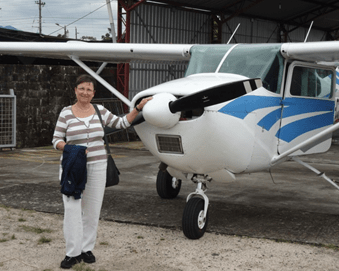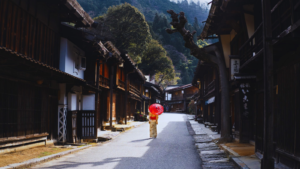by Elizabeth Bekes
“And the Wachirpas shaman, Sumpa is also coming at the weekend,” I tell my daughter during our Sunday walk by the Tomebamba river and she laughs out loud. “What’s so funny?” I ask. “If I had told you five years ago”, replies my daughter amused, “that you would be so matter-of-factly stating that the shaman from Wachirpas, who is an acquaintance of yours, is coming to Cuenca, what would you have said?”

Our conversation takes me back to when I first heard the word shaman. One of my students, a boat driver at the jungle lodge cancelled his English class, because he had to take his sick wife to the shaman. Over my 40 years as an English teacher, I’d never had that as an excuse.
It is surreal, of course. Not only did I leave Europe to move to Ecuador, but a year later I decided to take up a volunteer post deep in the jungle to teach English to members of an isolated tribe, the Achuar. My time was split between Kapawi Eco-Lodge and the school in the neighbouring community of Kapawi. My task was to teach General English and English for Tourism both to the staff of the Eco-Lodge, as well as to students from Kapawi and the neigbbouring communities; I also did teacher training and survival English for Achuar guides.
I am not sure about the exact numbers right now, but there might be about 85 small Achuar communities along the Pastaza river with about 8,000 inhabitants, and another 15.000 living on the Peruvian side. The largest communities may have a few more than 300 members, the smallest only about seven extended families (a rule when they secede from a more populous community).
The Achuar still adhere to their traditional life-style:
their spacious, oval-shaped, palm-fronded huts are divided into two parts: about two-thirds constitute their public space; one third is private and is separated by wooden planks from the rest. That side of the house opens onto their sacred gardens, where women sing to their plants and often give birth. That’s where the yucca is grown to be made into the fermented drink called chicha. It is a nutritious drink, tastes a bit like yoghurt on the brink of going off, but when there is nothing else to eat, it keeps the members of the tribe going.
The hunting grounds and the rivers have been disturbed for decades now, so there are fewer animals and less fish around. If there is a festive occasion, male members of the community will go on a hunting and fishing expedition, while the women get out the smoked meat of monkeys or creatures that resemble small wild boars. I have eaten both.
Myths are still alive, just as the ceremonies of coming of age, usually related to drinking ayahuasca (a strong hallucinogenic cocktail) for the first time, on an empty stomach, after days of fasting. The hallucinations usually involve apparitions by the giants of the jungle (jaguars, snakes, river dolphins) telling you about the course of your future life and the path that you have to follow; often it’s the ancestors advising the young Achuar.
In the 1970s, the Achuar started settling down and establishing communities that are now in touch with the outside world. The quickest way to get into the jungle is to fly from Shell (near Puyo) by one of the small airlines that usually have a small fleet of three or four planes. The Achuar have their own company, called Aerotsentsak and they usually take the guests to Kapawi Eco-Lodge to Kusutkau or even Wachirpas, which is close by (and where the shaman, Sumpa, lives). My favourite was the small, four-seater Cessna, which looked like a WWII relic. “Get in, sit down, shut up and hang on”, said the label stuck above the instruments next to the pilot on the plane, as we glided over what looked like an immense expanse of broccoli…
On and off, I stayed in the jungle for about six months. I did my best to teach as much English as I could in a low resource environment, without books and anything much to start with. By the time I left, the incoming volunteers had a printer/scanner/photocopier, a radio cassette/CD player, sets of dictionaries, laminated maps, games (bingo was a favourite, and what a great way to practise numbers) and an amount of stationery that would have put the Peruvian merchant (travelling by boat up and down the Pastaza river) to shame.
I took guests from the Lodge to observe my English classes and engage with my students.
The very same tourists left donations to buy solar lamps and large size maps of the world. Others (including the editor-in-chief of the Washington Post, Martin Baron, the most unassuming guy I have ever met in my life) helped me support an Achuar student for a year in Cuenca. Donations came from a Quito-based educational charity (The Condor Trust), and we had some truly amazing volunteers teaching English; all of them in their own way, walking around in the jungle, acting out Achuar myths or even teaching the students cheerleader routines. From the donations we received, members of the Kapawi community built a hut for their arts and crafts to display to tourists and we were able to replace the solar panels and their batteries as well. There is now a small Achuar museum in Wachirpas, and the IKIAM Foundation is actively working on documenting and preserving the collective memory of their unique culture.
I miss the jungle that comes alive at night, the sounds of the bats and rats, the lizards, the frogs, the sight of the beautiful blue morpho butterfly, the howler monkeys and the gentle snore of the pink dolphins that can come up so close to the dugout canoes that you could touch their heads.
So it was a joy that ten members of the Achuar recently came to what I now call my home town, Cuenca. We had three days of presentations including acting out an Achuar myth, showing the expats the Achuar ritual of “warrior dialogues” when preparing for war (which sound like the scary scenes of “Lost in Translation”, only louder), sacred anents (songs that are passed on from mothers to daughters) and a detailed description of the ayahuasca ceremony.
I went up to Sumpa, holding his hand and asked him if he remembered me as the Kapawi volunteer. I told him how I missed my students and the life I had in the jungle. He smiled and nodded gently. “Does Sumpa speak Spanish?, I asked Ines a little later. “No, he only speaks Achuar,” came the answer. I knew he understood all the same.
Link:
Fundación IKIAM
Jungle Job (blog)
https://junglejob.blogspot.com/2012/10/we-arrived-in-tiny-cessna-182-that.html




